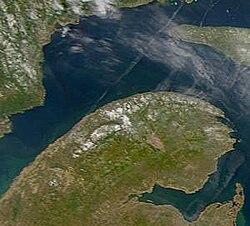Gaspé Peninsula: Difference between revisions
DocWatson42 (talk | contribs) Cleaned up image placement (to eliminate overrunning the appendices in wide browser windows) and other matters. |
Rescuing 1 sources and tagging 0 as dead. #IABot (v1.2.7.1) |
||
| Line 90: | Line 90: | ||
* [http://www.gaspesie.net Gaspesie.net] |
* [http://www.gaspesie.net Gaspesie.net] |
||
* [http://www.gaspesie.com Gaspesie.com] |
* [http://www.gaspesie.com Gaspesie.com] |
||
* [http://www.gaspesia.com/ville.php Municipalities and cities of Gaspé region] |
* [https://web.archive.org/web/20070928192457/http://www.gaspesia.com/ville.php Municipalities and cities of Gaspé region] |
||
* [http://www.tourisme-gaspesie.com/en/accueil.html Tourism Gaspésie] |
* [http://www.tourisme-gaspesie.com/en/accueil.html Tourism Gaspésie] |
||
* {{Cite Americana|short=1|wstitle=Gaspé}} |
* {{Cite Americana|short=1|wstitle=Gaspé}} |
||
Revision as of 10:51, 8 January 2017
You can help expand this article with text translated from the corresponding article in French. (June 2010) Click [show] for important translation instructions.
|
Gaspé Peninsula | |
|---|---|
 NASA satellite image of the Gaspé Peninsula. Part of Anticosti Island appears to the northeast. | |
| Country | |
| Province | |
| Area | |
| • Land | 31,075.36 km2 (11,998.26 sq mi) |
| Population (2011)[1] | |
| • Total | 140,599 |
| • Density | 4.5/km2 (12/sq mi) |
The Gaspésie (official name), or Gaspé Peninsula, the Gaspé or Gaspesia, is a peninsula along the south shore of the Saint Lawrence River to the east of the Matapédia Valley in Quebec, Canada, that extends into the Gulf of Saint Lawrence. It is separated from New Brunswick on its southern side by the Baie des Chaleurs (Chaleur Bay) and the Restigouche River.
The origin of the name "Gaspé" comes from the Mi'kmaq word gespe'g, meaning "end", referring to the end of the land.[2] A Basque linguist has instead suggested "Gaspé" comes from a mutation of the Basque word "geizpe", meaning "shelter", however this view is disputed.[3]
The Gaspé Peninsula is slightly larger than Belgium, at 31,075 square kilometres (11,998 sq mi).[4] The population is 140,599 as of the 2011 census.[5]
Landscape
Sea cliffs dominate the peninsula's northern shore along the St. Lawrence River.[6] Cap Gaspé, jutting into the Gulf of St. Lawrence, is the easternmost point of the peninsula. Percé Rock (or Rocher Percé), an island pierced by a natural arch, is located just offshore of the peninsula's eastern end. The peninsula's interior is a rugged northward continuation of the Appalachian Mountains called the Chic-Chocs, with Mont Jacques-Cartier at 1,268 metres (4,160 ft) the peninisula's highest peak.
Mount Albert (Mont Albert) at 1,151 m (3,776 ft)[7] is another high mountain in the Chic-Chocs. Its summit, an alpine area above the tree line, is a nearly flat plateau about 13 km (8 mi) across composed of serpentine bedrock and supporting a quite unusual flora.[8] The ascent of Mount Albert from near sea level is challenging, but popular with hikers, offering a view of the St. Lawrence and the Côte-Nord, the river's north shore, part of the ancient bedrock of the Canadian Shield.
Inland
The interior portions of the peninsula are dominated by the Chic-Choc Mountains, part of the Notre Dame Mountains, an extension of the Appalachian Mountains.
The town of Murdochville, at about 660 metres (2,170 ft) above sea level, has had a varied history, and is now home to several wind turbines. It is reached by Route 198, which extends inland from the northern shore of the peninsula, soon climbing into the mountains and entering vast forests, crossing several small rivers before reaching the town. From Murdochville, Route 198 follows the York River to the city of Gaspé on the peninsula's eastern tip.
-
Mont Albert, in the Chic-Choc Mountains of the Gaspé Peninsula.
-
Rocher Percé, circa 1900.
Economy
The economy of the peninsula has historically been focused on fishing, agriculture and forestry. However, primary resource based industries are suffering due to overfishing, overexploitation and fewer numbers of farmers in business, forcing the region to move towards tourism and the services industry.
Tourism
The peninsula is one of Quebec's most popular tourism regions. Route 132 circles the peninsula, with one branch following the coast and the other cutting across it at Sainte-Flavie, and a section of the International Appalachian Trail travels through the peninsula's mountains. The Gaspé National Park (Parc national de la Gaspésie) is located in the Chic-Chocs, and Forillon National Park is at the peninsula's northeastern tip.
See also
- Acadia
- Gaspé, Quebec
- List of people from the Gaspé Peninsula
- List of regions of Quebec
- Percé, Quebec
References
- ^ Statistics Canada Population and dwelling counts, for Canada, provinces and territories, and economic regions, 2011 and 2006 censuses - 100% data
- ^ Commission de toponymie
- ^ Rayburn, Alan (2001). Naming Canada: Stories about Canadian Place Names. Toronto, Canada: University of Toronto Press. p. 107.
- ^ Its area is determined by adding the area of two federal electoral districts, Haute-Gaspésie—La Mitis—Matane—Matapédia and Gaspésie—Îles-de-la-Madeleine, while subtracting that of the Magdalen Islands.
- ^ The population of the Gaspe Peninsula is determined by adding the population of two federal electoral districts, Haute-Gaspésie—La Mitis—Matane—Matapédia and Gaspésie—Îles-de-la-Madeleine, while subtracting that of the Magdalen Islands.
- ^ Fernald, M.L. (1932). "Botanizing on the Gaspé sea-cliffs". Harvard Alumni Bulletin. 36: 1–7.
- ^ Gouvernement du Québec (2011). "Mont Albert" (in French). Commission de toponymie. Retrieved 4 Jan 2011.
- ^ Scoggan, H.J. (1950). The Flora of Bic and the Gaspé Peninsula, Quebec. Ottawa, Canada: National Museum of Canada. p. 399.


